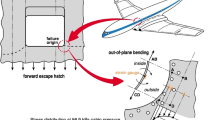Abstract
Multiple site damage (MSD) is a type of cracking that may be found in aging airplanes which can adversely affect the damage tolerance of an airframe structure. In this paper the behavior of MSD is studied by examining the interaction of cracks in stiffened and riveted panels. The hybrid finite element method, in conjunction with the complex variable theory of elasticity, is used to provide accurate and efficient solutions to these problems. Typical results include stress intensity factors at the crack tips, stress concentration factors in the stiffeners, and rivet loads for a stiffened structure with multiple cracks. Particular emphasis is placed on the derivation and interpretation of residual strength diagrams. This study produces a better understanding of the interaction between multiple cracks and provides insight for avoiding MSD in future designs.
Similar content being viewed by others

References
Tong, P.; Sampath, S. G.; Broek, D. (1991): Aging aircraft, detection of MSD, and the risk of failure, ICAF Conf., Japan
Tong, P.; et al. (1991): Current DOT research on the effect of multiple site damage on structural integrity. Int. Conf. on Aging Aircraft and Structural Airworthiness, Washington, D.C.
EnglandA. H. (1971): Complex variable methods in elasticity. Wiley Interscience, London
TongP. (1984). A hybrid finite element method for damage tolerance analysis. Computers and Structures 19(1–2), pp. 263–269
TongP.; GreifR.; ChenL., (1990): Application of hybrid finite element method to aircraft repairs. 22nd Conf. on Frac. Mech., Atlanta, Georgia, also ASTM STP 1131, Vol. 2, pp. 154–169
Tong, P.; Greif, R.; Chen, L. (1991): A hybrid finite element method for damage tolerance analysis of structures with multiple site damage. Int. Conf. on Comp. Eng. Sci., Melbourne, Australia, August
Atluri, S. N.; Sampath, S. G.; Tong, P. (1991): Computational schemes for integrity analyses of fuselage panels in aging airplanes. In: Atluri, S. N.; Sampath, S. G.; Tong, P. (eds.): Structural integrity of aging air-planes. Springer-Verlag
GladwellG. M. L.; EnglandA. H. (1977): Orthogonal polynomial solution to some mixed boundary-value problems in elasticity theory. Q. J. Mech. Appl. Math., Vol. XXX, Pt. 2, 175–185
TadaH.; ParisP.; IrwinG. (1985): The stress analysis of cracks handbook, 2nd Edn. Paris Productions, Inc., St. Louis
Swift, T. (1979): Damage tolerance analysis of redundant structures. AGARD Lectures Series No. 97, Fracture Mechanics Design Methology
Damage tolerance and fatigue evaluation of structure, FAR 25.571 and FAA AC 25.571.1, FAA Airworthiness requirements, 1978
Airplane damage tolerance requirements. Military specification, MIL-A-83444 (USAF), (1974)
Author information
Authors and Affiliations
Additional information
Communicated by S. N. Atluri, January 12, 1993
This work was supported by the Technical Center, Federal Aviation Administration, U.S. Department of Transportation
Rights and permissions
About this article
Cite this article
Tong, P., Greif, R. & Chen, L. Residual strength of aircraft panels with multiple site damage. Computational Mechanics 13, 285–294 (1994). https://doi.org/10.1007/BF00350230
Issue Date:
DOI: https://doi.org/10.1007/BF00350230



